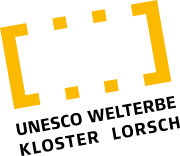
Concept & Mission
The Lauresham Laboratory for Experimental Archaeology is a 1:1 model of a Carolingian manorial site (curtis dominica) from around 800 AD and thus the ideal (re)construction of a large early medieval farmstead. Since 2012, an ensemble of various farm, residential, storage and stable buildings as well as a chapel has been built on an area of 4.1 hectares under scientific supervision on the basis of the latest research findings in settlement archaeology. In addition, various agricultural areas, i.e. meadows, pastures, gardens and arable land, were integrated into the open-air laboratory. Pigs, cattle, geese, chickens and even sheep are used on the grazing areas, all of which are not only intended to convey a vivid impression of the appearance of medieval farm animals and thus serve as a didactic tool, but also play an important role in their actual use as farm animals, such as the draught cattle. The use of old livestock breeds, which is often necessary for this purpose, offers the opportunity to carry out conservation breeding work for these usually highly endangered animal species. The selection of plants for the vegetable garden in the manor grounds is based in particular on the so-called capitulare de villis, possibly Charlemagne’s crown estate ordinance. The fields are cultivated in a long-term experimental archaeological trial with draft cattle of the Rhaetian gray cattle breed and various (re)constructions of historical agricultural implements. Overall, Lauresham aims to present a vivid and lively picture of the working and everyday life of people in the early Middle Ages. An active coexistence of the two central pillars of research and education is of particular concern to us.
Education
In terms of educational work, the Lauresham open-air laboratory fulfills several functions within the overall didactic concept of the Lorsch Abbey World Heritage Site. On the one hand, it provides a multifaceted insight into the reality of life in the early Middle Ages and thus brings the topic of everyday culture in the early Middle Ages more into focus. The advantages of a 1:1 model are particularly evident here, as this concept allows very direct and lively access to topics such as house building, home comfort, crafts, animal husbandry, agriculture and luxury. With this form of presentation, it is also possible to rethink prevailing clichés about the supposedly “dark Middle Ages” in a simple and playful way and to show that the foundations of the most diverse aspects of the present day were created in this epoch.
On the other hand, Lauresham provides access to the topic of lordship, which is so central to understanding the early medieval monastery of Lorsch. As an abstract concept of order that is often very difficult to convey, the organizational patterns of such a manorial estate can be illustrated quite simply using the manor character of Lauresham. In the context of the didactic concept, Lauresham should therefore also be regarded as the center of a small manorial unit. The central courtyard should be understood as the center of life of a family of the early medieval upper class(nobilitas) with its associated unfree serfs(servi, mancipia), but also as a collection point for levies from estates, some of which were located far away. The different houses represented in the open-air laboratory are therefore not only intended to illustrate the economic complexity of the manorial system, but also to reveal the social structure reflected in it: The simple residential and farm buildings of the peasants are juxtaposed with the luxuriously furnished manor house. The Lauresham concept also provides an impression of monastic land ownership. Many landlords donated their estates to the saints of the monasteries out of concern for their salvation, which also enabled Lorsch Monastery to expand its dominion from the Dutch North Sea coast to the Swiss Grisons. Such manor houses as (the fictitious) Lauresham could often take on important functions within the system of levies and servitude of such an ecclesiastical community.
Last but not least, the didactic implementation of Lauresham also allows a more direct approach to the subject of faith and the church, which is not always easy due to the fragmentary character of the monastery complex on site. The (re)constructed chapel also plays a special role here. It is the only stone building on the open-air site where architectural sculpture and furnishings can be shown in a coherent context. Lauresham therefore also fulfills the special task of learning to better understand Lorsch Abbey, which is now largely destroyed. Even the gatehouse is easier to imagine on the basis of the Lauresham chapel, as the angle of the chapel’s roof pitch corresponds exactly to that of the Carolingian gatehouse, which has now been altered by the Gothic barrel vault.



